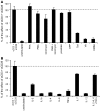Small-molecule screening using a human primary cell model of HIV latency identifies compounds that reverse latency without cellular activation
- PMID: 19805909
- PMCID: PMC2769176
- DOI: 10.1172/JCI39199
Small-molecule screening using a human primary cell model of HIV latency identifies compounds that reverse latency without cellular activation
Abstract
The development of highly active antiretroviral therapy (HAART) to treat individuals infected with HIV-1 has dramatically improved patient outcomes, but HAART still fails to cure the infection. The latent viral reservoir in resting CD4+ T cells is a major barrier to virus eradication. Elimination of this reservoir requires reactivation of the latent virus. However, strategies for reactivating HIV-1 through nonspecific T cell activation have clinically unacceptable toxicities. We describe here the development of what we believe to be a novel in vitro model of HIV-1 latency that we used to search for compounds that can reverse latency. Human primary CD4+ T cells were transduced with the prosurvival molecule Bcl-2, and the resulting cells were shown to recapitulate the quiescent state of resting CD4+ T cells in vivo. Using this model system, we screened small-molecule libraries and identified a compound that reactivated latent HIV-1 without inducing global T cell activation, 5-hydroxynaphthalene-1,4-dione (5HN). Unlike previously described latency-reversing agents, 5HN activated latent HIV-1 through ROS and NF-kappaB without affecting nuclear factor of activated T cells (NFAT) and PKC, demonstrating that TCR pathways can be dissected and utilized to purge latent virus. Our study expands the number of classes of latency-reversing therapeutics and demonstrates the utility of this in vitro model for finding strategies to eradicate HIV-1 infection.
Figures









Similar articles
-
Combination of biological screening in a cellular model of viral latency and virtual screening identifies novel compounds that reactivate HIV-1.J Virol. 2012 Apr;86(7):3795-808. doi: 10.1128/JVI.05972-11. Epub 2012 Jan 18. J Virol. 2012. PMID: 22258251 Free PMC article.
-
Disulfiram reactivates latent HIV-1 in a Bcl-2-transduced primary CD4+ T cell model without inducing global T cell activation.J Virol. 2011 Jun;85(12):6060-4. doi: 10.1128/JVI.02033-10. Epub 2011 Apr 6. J Virol. 2011. PMID: 21471244 Free PMC article.
-
Novel structurally related compounds reactivate latent HIV-1 in a bcl-2-transduced primary CD4+ T cell model without inducing global T cell activation.J Antimicrob Chemother. 2012 Feb;67(2):398-403. doi: 10.1093/jac/dkr496. Epub 2011 Dec 7. J Antimicrob Chemother. 2012. PMID: 22160146 Free PMC article.
-
Therapeutics for HIV-1 reactivation from latency.Curr Opin Virol. 2013 Aug;3(4):394-401. doi: 10.1016/j.coviro.2013.06.001. Epub 2013 Jun 28. Curr Opin Virol. 2013. PMID: 23810462 Review.
-
The development of immune-modulating compounds to disrupt HIV latency.Cytokine Growth Factor Rev. 2012 Aug-Oct;23(4-5):159-72. doi: 10.1016/j.cytogfr.2012.05.003. Epub 2012 Jul 4. Cytokine Growth Factor Rev. 2012. PMID: 22766356 Review.
Cited by
-
Combination of biological screening in a cellular model of viral latency and virtual screening identifies novel compounds that reactivate HIV-1.J Virol. 2012 Apr;86(7):3795-808. doi: 10.1128/JVI.05972-11. Epub 2012 Jan 18. J Virol. 2012. PMID: 22258251 Free PMC article.
-
A flexible model of HIV-1 latency permitting evaluation of many primary CD4 T-cell reservoirs.PLoS One. 2012;7(1):e30176. doi: 10.1371/journal.pone.0030176. Epub 2012 Jan 24. PLoS One. 2012. PMID: 22291913 Free PMC article.
-
Modeling HIV-1 Latency Using Primary CD4+ T Cells from Virally Suppressed HIV-1-Infected Individuals on Antiretroviral Therapy.J Virol. 2019 May 15;93(11):e02248-18. doi: 10.1128/JVI.02248-18. Print 2019 Jun 1. J Virol. 2019. PMID: 30918072 Free PMC article.
-
Barriers for HIV Cure: The Latent Reservoir.AIDS Res Hum Retroviruses. 2018 Sep;34(9):739-759. doi: 10.1089/AID.2018.0118. Epub 2018 Aug 28. AIDS Res Hum Retroviruses. 2018. PMID: 30056745 Free PMC article. Review.
-
Modeling simian immunodeficiency virus (SIV) latency in primary rhesus macaque CD4+ T cells.bioRxiv [Preprint]. 2025 Jul 28:2025.04.22.650029. doi: 10.1101/2025.04.22.650029. bioRxiv. 2025. PMID: 40766556 Free PMC article. Preprint.
References
Publication types
MeSH terms
Substances
Grants and funding
LinkOut - more resources
Full Text Sources
Other Literature Sources
Research Materials

